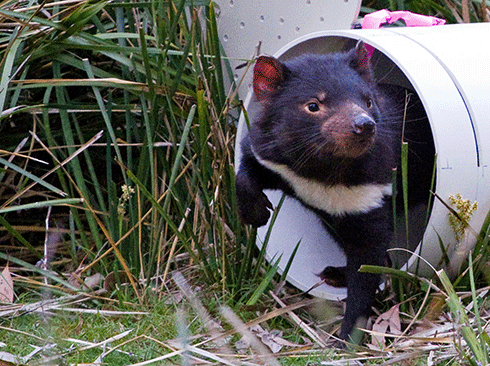
|
Published: 3 March 2014
US zoo joins fight to help save Tassie devil
An American zoo is partnering with an Australian university to help save the Tasmanian devil in the wild.

|
|
A disease-free devil being released on Maria Island, off Tasmania’s east coast. Credit: Save the Tasmanian Devil Program
|
San Diego Zoo Global and the University of Sydney are collaborating to assist the endangered marsupial, through the reintroduction and management of a disease-free population. Tasmanian devils have become increasingly threatened in the wild by the spread of a fatal cancer.
‘These populations will be managed in the best possible way to maintain the genetic diversity of the species,’ said Professor Kathy Belov, Faculty of Veterinary Science at the University of Sydney.
The Tasmanian devil faces extinction in the wild within 25 years because of Devil Facial Tumour Disease which has already wiped out 85 per cent of Tasmanian devils since 1996.
‘Ultimately the disease will wipe out devils in the wild but these newly created disease- free populations will be used to repopulate the wild once it is safe to do so.’
An important part of the project is the reintroduction of 50 devils to Maria Island, off the east coast of Tasmania. The group will be carefully managed, much as it would be in a zoo, by selecting disease-free individuals and preserving genetic diversity.
‘The cancer is spread through physical contact of one Tasmanian devil with another and unfortunately no cure has been discovered,’ said Bob Wiese, Chief Life Sciences Officer for San Diego Zoo Global.
‘By managing a genetically diverse population safe from the disease we hope to save the species.’
The University of Sydney is well known for its leadership in the genetic sequencing of the devil and this expertise will be used to capture a snap-shot of genetic variation in the devils being bred in zoos and breeding facilities.
San Diego Zoo Global is contributing A$500,000 to the project, including funding the employment of conservation geneticist, Catherine Grueber, at the University.
San Diego Zoo Global has a long history of interest in Australian wildlife. It hosts the largest koala population outside of Australian zoos and it recently acquired Tasmanian devils.
Other institutions collaborating in the Devil Tools and Tech project are the Save the Tasmanian Devil Program and the Zoo and Aquarium Association Australasia.
‘To save this species we are combining our expertise,’ Professor Belov said.
‘To manage existing populations and to boost devil numbers we will be using all the available tools, from GPS tracking to microchipping and the latest genetic sequencing technology.’
Bringing species back from the brink of extinction is the main priority of San Diego Zoo Global, which has field programs in more than 35 countries.
Source: University of Sydney



